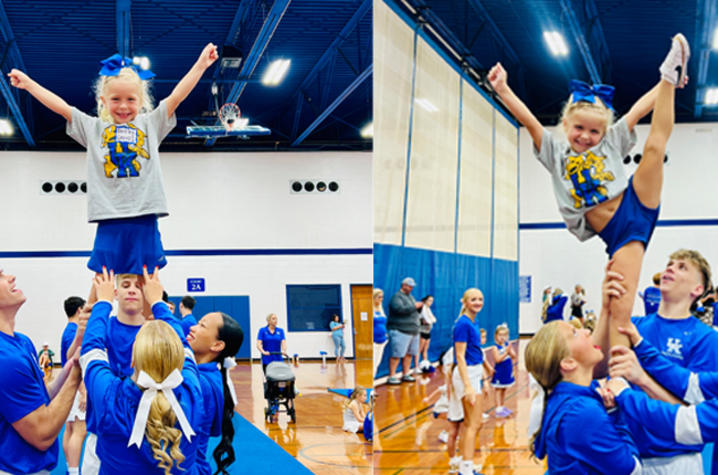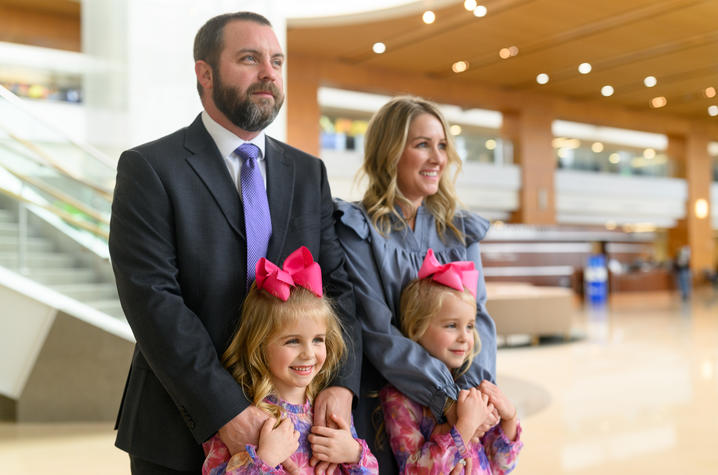Double the courage: Twins born with heart defects define resiliency
LEXINGTON, Ky. (Feb. 11, 2025) – Even though 6-year-old Danville twins Lennox and Berkley Frey look the same, they couldn’t be more different.
Lennox is a “girly-girl,” dressed to the nines in cute outfits with perfectly styled hair. Berkley prefers sweatpants and rock ’n’ roll t-shirts. Lennox likes pizza and chicken nuggets. Berkley is happy with salads and vegetables.
Even from an early age, the differences in their preferences and personalities were obvious to their parents Alana and Jared. But the twins had one, very serious thing in common. Both were born with heart defects.
“They are IVF babies, and I was 35 and high-risk, so we had more appointments than you can imagine,” said Alana. “We had all the blood tests, checked for spina bifida, Down Syndrome, all the other checks. Never once did they say anything about heart issues.”
On the morning Alana and the twins were to be discharged from the hospital, a final exam revealed both girls had a heart murmur. The Freys followed up with their pediatrician weekly for the next few months, but neither girl showed any signs of improvement. One pediatric cardiologist told Alana and Jared that both girls had heart defects, and that open heart surgery was the only treatment.
“I immediately asked for a second opinion,” said Alana. “Here I am with 2-month-old babies, and you’re telling me that both have mitral valve clefts, and that the only way they can be repaired is having their chests cracked open.”
The Freys met with Callie Rzasa, M.D., medical director of the Kentucky Children’s Hospital (KCH) Congenital Heart Clinic, part of Joint Pediatric and Congenital Heart Program. Established in 2017, the joint program is a partnership between KCH and Cincinnati Children’s Hospital Medical Center, bringing together the expertise of Kentucky’s top hospital and the country’s best children’s hospital to create one of the top pediatric heart programs in the country as ranked by U.S. News & World Report. Alana said they knew right away they were in the right place.
“Dr. Rzasa quickly became family,” she said. “We were all overly emotional, with no clue of what we were getting into. But the way she handled my kids and the way she handled us was significantly different from our original experience.”
Tests revealed that Berkley did have a cleft mitral valve, in fact she had a condition referred to as a partial, or transitional atrioventricular canal defect. This a rare defect that occurs when the normal migration of heart tissue during fetal cardiac development does not complete, or stops before making the typical heart valves. When this happens, there is a hole or defect in one of the mitral valve leaflets, and a hole in the wall between the atria called an ostium primum defect. The mitral valve has two leaflets that open and close with each heartbeat to keep the blood flowing in the right direction. Additionally, she had two ostium primum atrial septal defects. These defects allow blood to recirculate through the right side of her heart and lungs. Over time, this causes failure to thrive and makes it difficult for children to grow and exercise. If left untreated, it can significantly change a person’s physical ability and could shorten their lifespan.
Lennox was diagnosed with mitral valve prolapse, a less severe condition that did not require surgery.
Rzasa and her team watched Berkley and Lennox carefully over the next few years. Just before the twins’ fourth birthday, right before a celebratory trip to Disney World, Alana and Jared were told that the time for Berkley’s surgery had come. Alana was thankful they had the flexibility to schedule Berkley’s surgery, choosing a date in the spring so that Berkley could recover in time for summer activities.
Berkley’s surgery was performed by Carl L. Backer, M.D., division chief of Pediatric Cardiothoracic Surgery, and William J. Wallen, M.D. After hooking Berkley up to a heart-lung bypass machine, Backer and Wallen stopped her heart and opened the upper right chamber. The cleft in the valve was then closed with sutures to bring the edges together, and the hole between the upper chambers was closed by sewing in a small patch, using a piece of the sac that surrounds the heart. The surgeons closed an additional small hole between the upper chambers with a single stitch. Berkley’s condition and the necessary surgery are somewhat rare; the pediatric cardiothoracic surgery team sees cases like Berkley’s about once a month.
“I have nothing but praise for the UK pediatric cardiology team,” Alana said. “There’s fear that comes with sending your child back into the unknown, with people who are still kind of strangers no matter how much time we’ve spent with them — it’s still scary. They made us feel at ease during the eight hours we sat there. I don’t know that I’ll ever be able to explain the appreciation we have for how they cared for her. The whole experience, as traumatizing and emotional as it was, could have been significantly different if we didn’t have KCH and the pediatric cardiology staff.”
Berkley spent several days in the hospital. It was hard on both girls — they had never been separated for more than an hour. When Berkley realized that the sooner she walked after surgery, the sooner she could go home to her sister; her determination came through. Berkley showed remarkable resiliency and vigor. Four days after surgery, she was ready to go home. Of course, Lennox was right alongside her parents, ready to bring her sister home from the cardiac ICU.
Alana says Lennox and Berkley are both biggest rival and greatest cheerleader for each other. While they try to prevent each other from scoring goals in soccer — even when playing on the same team — they are fiercely protective of each other. Once, another child pushed Berkley in the chest on the playground and Lennox made sure everyone knew that wasn’t ok. When Berkley was down on herself for not being as flexible as her sister during cheer, Lennox gently reminds her that she’s still recovering and that she needs to take it easy.
Berkley follows up with Rzasa every six months. Lennox will be seen every three years. Mitral valve prolapse is a condition in which one or both of the mitral valve leaflets have extra tissue or stretch more than usual. The leaflets can bulge backward into the left upper heart chamber each time the heart contracts to pump blood, keeping the valve from closing tightly. One potential complication of mitral valve prolapse is quicker wear and tear on the mitral valve leaflets over time, resulting in more of a leak of that valve. Patients are also at risk for arrhythmias, specifically atrial fibrillation later in life, a heart condition that causes the upper chambers of the heart to beat irregularly and rapidly.
Studies have shown only 34-67% of infants needing surgery in the first year of life are diagnosed before birth, according to a review using the Society of Thoracic Surgeons Congenital Heart Surgery Database. That means the condition in many infants is not detected until after birth, or even after they are home from the hospital. The National Institutes of Health estimates that 10% of patients with congenital heart disease are not diagnosed until they are adults. Some conditions can be mild with few to no symptoms; others can be life-threatening without medical intervention. Regular preventive care with a primary care provider can help detect these concerns, and this starts with prenatal care. Rzasa encourages everyone, young and old, to check in with their primary care providers annually and seek immediate medical care in the event of cardiac symptoms such as irregular heartbeat, shortness of breath, chest pain or fatigue with activity and exercise.
The twins are now six and in kindergarten. They do have some limitations on their activities, such as not being able to explore the ocean floor in a submarine, climb Mt. Everest or serve in the military — all of which are just fine with their parents. They’re back to their favorite pastimes, including competitive cheering and sabotaging each other on the soccer field. But they also serve as ambassadors; Alana and the twins make frequent appearances at events for the American Heart Association (AHA), educating the public about the incidence rate and potential complications of heart defects.
“So much of heart disease is about lifestyle factors, and you wouldn’t know to look at family history unless something happened,” said Alana. “Heart defects are the leading birth defects. That’s why I don’t mind sharing our story. It’s scary to think about how many people might be walking around with something and they don’t know.”
UK HealthCare is the hospitals and clinics of the University of Kentucky. But it is so much more. It is more than 10,000 dedicated health care professionals committed to providing advanced subspecialty care for the most critically injured and ill patients from the Commonwealth and beyond. It also is the home of the state’s only National Cancer Institute (NCI)-designated Comprehensive Cancer Center, a Level IV Neonatal Intensive Care Unit that cares for the tiniest and sickest newborns and the region’s only Level 1 trauma center.
As an academic research institution, we are continuously pursuing the next generation of cures, treatments, protocols and policies. Our discoveries have the potential to change what’s medically possible within our lifetimes. Our educators and thought leaders are transforming the health care landscape as our six health professions colleges teach the next generation of doctors, nurses, pharmacists and other health care professionals, spreading the highest standards of care. UK HealthCare is the power of advanced medicine committed to creating a healthier Kentucky, now and for generations to come.










